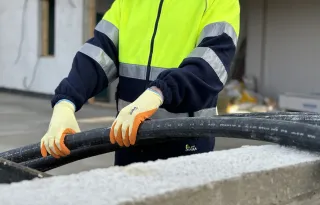
Technical articles
What work clothing should look like in construction work
Work in the construction sector often presents great risks, given that it involves a wide variety of different tasks, so professionals must be equipped appropriately and as safely as possible.
In view of this need, it is essential to choose the most suitable construction workwear for each situation, so that it provides safety for the professional and at the same time allows him to carry out his tasks with maximum comfort. In any case, in this sector it is very important to take into account the weather, which affects the day-to-day work of these professionals.
What are the regulations for work clothes in the construction sector?
The employer is responsible for protecting the health and safety of workers in the workplace. It also states that the clothing must be comfortable, resistant and suitable for the work to be carried out.
The types of PPE (Personal Protective Equipment) by establishing a distinction into three categories according to the type of risk to which workers are exposed.
In the construction sector, PPE and other work wear fall into category III, associated to mandatory elements in case of extreme risk.
What clothes to wear in construction work
Construction work clothes depend very much on the tasks to be carried out by each professional. Specifically, some of the most frequent options we can find:
Long-sleeved shirts : made of resistant but light materials. Designed to protect the professional's arms from debris and splashes.
Trousers : made of materials specifically designed to prevent tearing, to fully protect workers' legs.
Rainwear : waterproof or water-resistant, depending on the need in each work environment, offering protection from adverse weather conditions.
Thermal clothing : designed for use in cold climates or low temperature areas.
100% cotton clothing : to protect against sparks in a job, for example, welding.
Chemical protective clothing : for work involving chemicals that are hazardous if they come into contact with the skin.
High visibility clothing : if the work is being carried out in an area close to vehicular traffic.
What types of work safety clothing are available for the construction industry?
This is construction workwear that may be required depending on the needs of each professional.
Safety clothing, which is usually worn by all construction professionals, should also be taken into account. These are mainly the following items:
High-visibility clothing
Garments with a reflective finish, allowing workers to be seen in low visibility situations, even to safely carry out their work at night.
As heavy machinery is used in construction, high-visibility clothing is a must.
Safety footwear
The footwear worn by construction workers must allow them the best possible mobility, even on uneven surfaces. They must also protect their feet against various risks such as cuts, blows or falling objects.
Protective helmets
Another essential element in construction, as it protects the professional's head against possible impacts.
A suitable helmet should be approved at European level, fit the worker's head properly and should generally have an outer cap and an inner harness to guarantee protection and support at the best possible level.
Work gloves
In construction, manual work is carried out with tools that can pose a risk and in conditions that can also be dangerous due to different characteristics.
The wide variety of gloves for construction work is evident in Juba's catalogue, with over 500 references, many of them applicable to this sector.
Each glove has different characteristics, which make it suitable for a particular type of work. It is important to identify their materials and properties in order to choose the most suitable glove for each situation.
Juba distinguishes up to ten work environments related to a construction project, each with different recommended glove types :
Signage and preparation.
Earthworks.
Foundations and structure.
Roofing.
Insulation and waterproofing of the house.
Masonry and enclosures.
Installations (plumbing, electricity, telecommunications).
Carpentry.
Final finishes.
Final cleaning of the work.
26 November 2024
Read more

















